Local rivers update – the Goyt and the Sett
It’s time for an update on our lovely rivers – the Goyt and the Sett in the Mersey catchment, just upstream of Stockport and downstream of Buxton.
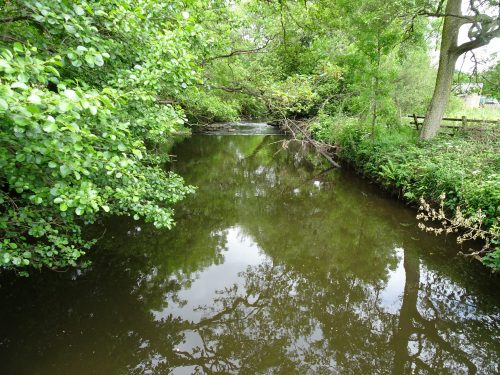
As you probably know, we had a long running pollution incident on the Goyt down at Mousley Bottom, which had an industrial source, and last year the situation came to a head with the low river levels concentrating the pollutants, climate change contributing further to a general summer raising of the water temperature, and some particularly heavy discharges of ochre from the old mine works in the area (the iron containing compound that gives the river a rusty-red colour at times and in places) all combining to produce a horrible bloom of sewage fungus which ran all the way down the river. Here is a reminder of what the river looked like, just over 12 months ago: https://youtu.be/RDGTQhEZKLc
Now though, 12 months later, those gravels are clear of sewage fungus. Like the good Lord himself, the river authorities move in mysterious ways so it is difficult to know exactly what led to action finally being taken. However, I am going to stick out my neck and hand out a big thank you here firstly to you, that is our community, for showing in numbers and that you gave a damn about our rivers. Second to me, for being in a position to bring a national media spotlight onto the problem if required, which probably matters more than it should, and third to Dr Paul Gaskell of the Wild Trout Trust for an authoritative and critical report on the situation on the Goyt and the Sett regarding water quality, which to be honest did not reflect well on any of us who consider these rivers to be in any way in our charge. Things need to change.
And last but by no means least to the Environment Agency, the body responsible for enforcing pollution regulations, for finally doing their job. I don’t mean that to sound as sarcastic as it might at first appear. OK then, perhaps I do a little bit.
But I am never entirely comfortable with the new national sport of ‘EA bashing’. I always feel it is only fair to point out that the Environment Agency has been absolutely hamstrung by cuts to their funding during the years of ‘austerity’,which has made it incredibly difficult for them to do their job effectively. More insidious than that, since its inception in 1995, there has been a shift in the regulatory framework that governs the policing of our rivers away from a purely environmental concern and towards business. Successive statutory guidance under the headline-grabbing guise of ‘cutting red tape’ furthered this move, as did allowing the water companies to ‘self report’ (or not!) on illegal sewage discharges into rivers and sea. For this ‘double whammy’ of regulatory drift and funding atrophy, we are now reaping the rewards: rewards you can see coming to just about any river near you.
If you want to learn more about this, read the superb report by Guy Linley-Adams, solicitor for Salmon & Trout Conservation (now Wildfish) titled ‘Doing its job’ where Linley-Adams gives the Government and Environment Agency the good filleting they so richly deserve.https://salmon-trout.org/wp-content/uploads/2021/04/Doing-its-job.stc_.pdf
I’d like to say that as the pollution source seems to have stopped, we now have a burbling river flowing over sparklingly clean gravels – but we don’t. This particular tableau is played out on an ugly base canvas of a river subject to algal growth due in part to raised nutrient levels caused by CSO discharges into the river – that is, when there is too much raw sewage and rainwater than the system can cope with, and the ‘escape valve’ releases it untreated into the river. The resultant algae that thrives in an environment of raised nutrients is the brown sludgy looking stuff that comes up in clouds when disturbed that you will notice cloaking the river bed. When combined with the lower flows and rising temperatures that seem to be characteristic of our warming climate, it does not make for a pleasant mix.
The River Sett you will remember also suffered a category 3 pollution event at the beginning of last year (2021) when a mains sewerage pipe cracked in a storm and spilled its raw sewage contents into the river. 18 months on and I am not seeing the progress I would like to see.
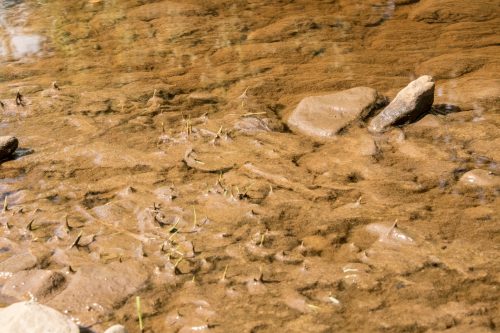 Incidentally, the Environment Agency now considers category 3 and 4 pollution events to be so ‘trivial’ that they do not even warrant investigation any more. On this stretch of the River Sett, 18 months on, the birdlife such as dippers, wagtails and kingfisher have still not recovered their numbers, and what is happening above the water is indicative of what is happening below. The EA’s ‘Incident Triage Response’ no longer investigates such incidents due to insufficient funds, cuts, efficient use of available resources… yeah right ok then, all so much blah blah fucking blah. Go over the Picker and take a look at the river – then multiply that by the myriad of rivers in the country suffering similarly – then tell me you think this is an adequate response to the routine trashing of our environment. This could be any river – River Anywhere – that is the point.
Incidentally, the Environment Agency now considers category 3 and 4 pollution events to be so ‘trivial’ that they do not even warrant investigation any more. On this stretch of the River Sett, 18 months on, the birdlife such as dippers, wagtails and kingfisher have still not recovered their numbers, and what is happening above the water is indicative of what is happening below. The EA’s ‘Incident Triage Response’ no longer investigates such incidents due to insufficient funds, cuts, efficient use of available resources… yeah right ok then, all so much blah blah fucking blah. Go over the Picker and take a look at the river – then multiply that by the myriad of rivers in the country suffering similarly – then tell me you think this is an adequate response to the routine trashing of our environment. This could be any river – River Anywhere – that is the point.
Let me remind you what Dr Paul Gaskell of the Wild Trout Trust said in his report on the Sett, written following his visit last summer (2021). You can find the report here:https://www.wildtrout.org/av/rivers-goyt-sett-derbyshire-advisory-visit
On Page 20 Gaskell says: “Further downstream on the Sett a cracked pipe beneath a riverside field – and potentially other sources – are associated with an apparent increase in nutrient levels and particulate runoff. The resulting gelatinous biofilm also appears to be trapping significant quantities of fine sediment and slurry material.”
As a Flyfisher, I know this section of river well. Many times I have seen families with small children swimming in that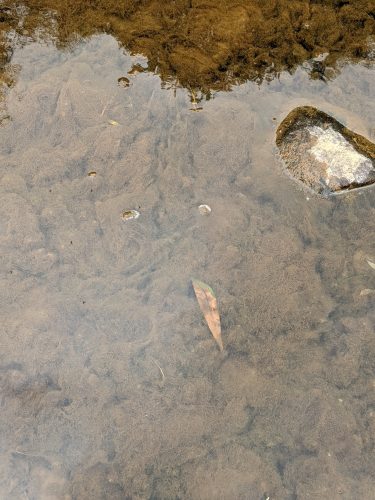 deeper water of the riverbend at the top end of the Picker, particularly during the time of lockdown restrictions, when so many people discovered the natural world on their own doorsteps. And why wouldn’t they? But look again at the language Gaskell uses in his report: “[…] significant quantities of fine sediment and slurry material.” We have created an environment where our children are potentially swimming in their own s#*t.
deeper water of the riverbend at the top end of the Picker, particularly during the time of lockdown restrictions, when so many people discovered the natural world on their own doorsteps. And why wouldn’t they? But look again at the language Gaskell uses in his report: “[…] significant quantities of fine sediment and slurry material.” We have created an environment where our children are potentially swimming in their own s#*t.
I don’t know the reasons for the condition of the Sett. I know that there is a marked difference in the river upstream and downstream of the bridge at Watford Road. I also know that there is a CSO at the bridge that is discharging at a declared rate of 196 hours in 2021, which represents a 44% increase on the 2020 data. This isn’t good, but I suspect it isn’t the whole story.
In case anybody is wondering what a CSO looks like, let alone a discharging one, I’ve filmed it so you don’t have to: I videoed this last year and I should warn those of a delicate disposition to look away now. Actually, I should perhaps run a competition – if you live in the Birch Vale area, you may well be able to spot your own turd here. If you do, you win a prize. Alternatively, if you do live in the CSO catchment and are on metered water, perhaps consider just going and taking a dump straight into the river to save a bit of money on the flush. You’re welcome. https://youtube.com/shorts/vcwsTF_8RNM?feature=share
Again, it is quite the thing to do to bash the water companies with CSO data like this (oops, I just did it too) a quick look at the main social media channels will reveal that it is a proper old pile-on.
I’ve got mixed feelings about all this. On the one hand it is good that the condition of our rivers is receiving so much media attention. On the other, there is a lot of misinformation flying about and it is being used to pursue particular political agendas. I might agree with some of them, but it has taken it a long way from a primary concern for the condition of our rivers and environment. I suppose those campaigning would say that you can’t make an omelette without breaking a few eggs. They may well be right.
For instance, I know many reading this will support the growing calls for nationalisation of the water industry. My heart might even agree. But I only have to engage a few cogs of my brain to remember an interview I did with someone who was well informed about the water industry. He said (I paraphrase): ‘Nationalise the water industry and it will be competing directly for funding for investment with schools, hospitals, and social and elderly care.’ That will be the health of our rivers at stake here and while I might struggle to predict the precise order of 1, 2 and 3 in the minds of the great British public, I have no such trouble predicting number 4, the one at the bottom. So to those calling for nationalisation I would cautiously ask only that they be careful what they wish for.
Besides, the real issue here is not whether the water industry is privately or publicly owned; run ‘not for profit’, such as in Wales (which is as big a basket case as ours) or publicly owned as in Scotland (which isn’t much better). The real issue is how much of society’s wealth are we prepared to allocate to ensure that we have clean water and a healthy environment?
For the last 40-odd years we have lived with a ‘low tax and low public spend’ ideology, an ideology that has equated ‘value’ with ‘cheap’, so the answer has been: ‘not much’. We are now living with the consequences of those choices. But that allocation of our collective resources is the really important question that we need to address first, the rest is just governance.
So to cut to the chase on our local rivers: are they dying? No. Are there worse rivers in the country? Absolutely there are. Are there worse rivers in our Mersey catchment? Absolutely there is – go across and have a look at the Tame that flows through Ashton into Stockport to see one of those. So what exactly am I moaning about then? What do I want out of our water company United Utilities? We should just count ourselves lucky, shouldn’t we?
Well no actually we shouldn’t. We shouldn’t be casting a sly eye across at the Tame like a couple of swaying drunks in a late-bar urinal. This is supposed to be a levelling up agenda, not levelling down. So the question we should be asking is: ‘Could our rivers here be better? In fact – should they?’ And the answer is a resounding ‘Yes.’
Up here on the Rivers Goyt and Sett, with the waters coming down from the moors above Buxton and on Kinder, we are in the headwaters of the Mersey rivers system. If there is a serious pollution event in the heavily populated regions of the river downstream, as they approach the cities – as has happened in the past – it is from up here that the populations of fish and invertebrates will recover. It is vital to the functioning of the overall system that these higher sections remain healthy – they are the insurance policy for the integrity of the whole.
Presumably the problem with CSO discharges here is the same as for rivers all over the country: insufficient capacity and bad management of surface water? I’ve just looked at the Rivers Trust map and we have got some horrors here.
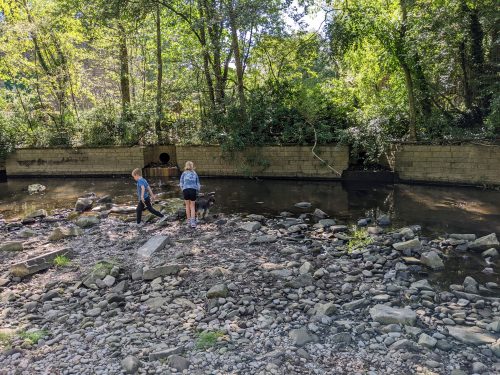 In addition locally, there is a pumping station and CSO in the Torrs that too often smells awful. It is unfortunately located at one of the most attractive sections of river, where visitors flock to let their young children paddle and their dogs chase sticks. If the wind is in the wrong direction the stink can linger over the town like a huge, Viz-inspired municipal fart. This is not the impression hard-working local businesses want to give to the increasing number of tourist visitors as they arrive in this lovely old mill town.
In addition locally, there is a pumping station and CSO in the Torrs that too often smells awful. It is unfortunately located at one of the most attractive sections of river, where visitors flock to let their young children paddle and their dogs chase sticks. If the wind is in the wrong direction the stink can linger over the town like a huge, Viz-inspired municipal fart. This is not the impression hard-working local businesses want to give to the increasing number of tourist visitors as they arrive in this lovely old mill town.
I understand this is a relatively simple fix that doesn’t involve a great deal of capital spend – not in the scheme of things. I mean, don’t even get me started on water executives’ pay.
So what would I ask of United Utilities in an ideal world?
Water industry funding runs in five year cycles and the next cycle runs from 2025-30. I would like to hear United Utilities’ spending plans here for the rest of the current investment cycle. Meanwhile, spending priorities for the next funding cycle are currently being determined and I would like to know what United Utilities intends to do to make the service here better and what we as a community can do to help. And I would like to hear firm plans, not corporate waffle.
After all, we all should want the same thing here: that is clean and safe water at an equitable cost coming out of our taps, and a return to rivers that are fit for man, woman, child and fish alike to swim in. It really shouldn’t be asking too much.
Did you know you can report issues to United Utilities if you think there is a problem? If you would like to stop the sewerage station down in the Torrs from smelling so badly as it is so off-putting for residents, visitors and the business of the town, why not give them a call on 0345 672 3723 and politely ask them if they would kindly do something about it at their earliest convenience? Thank you.

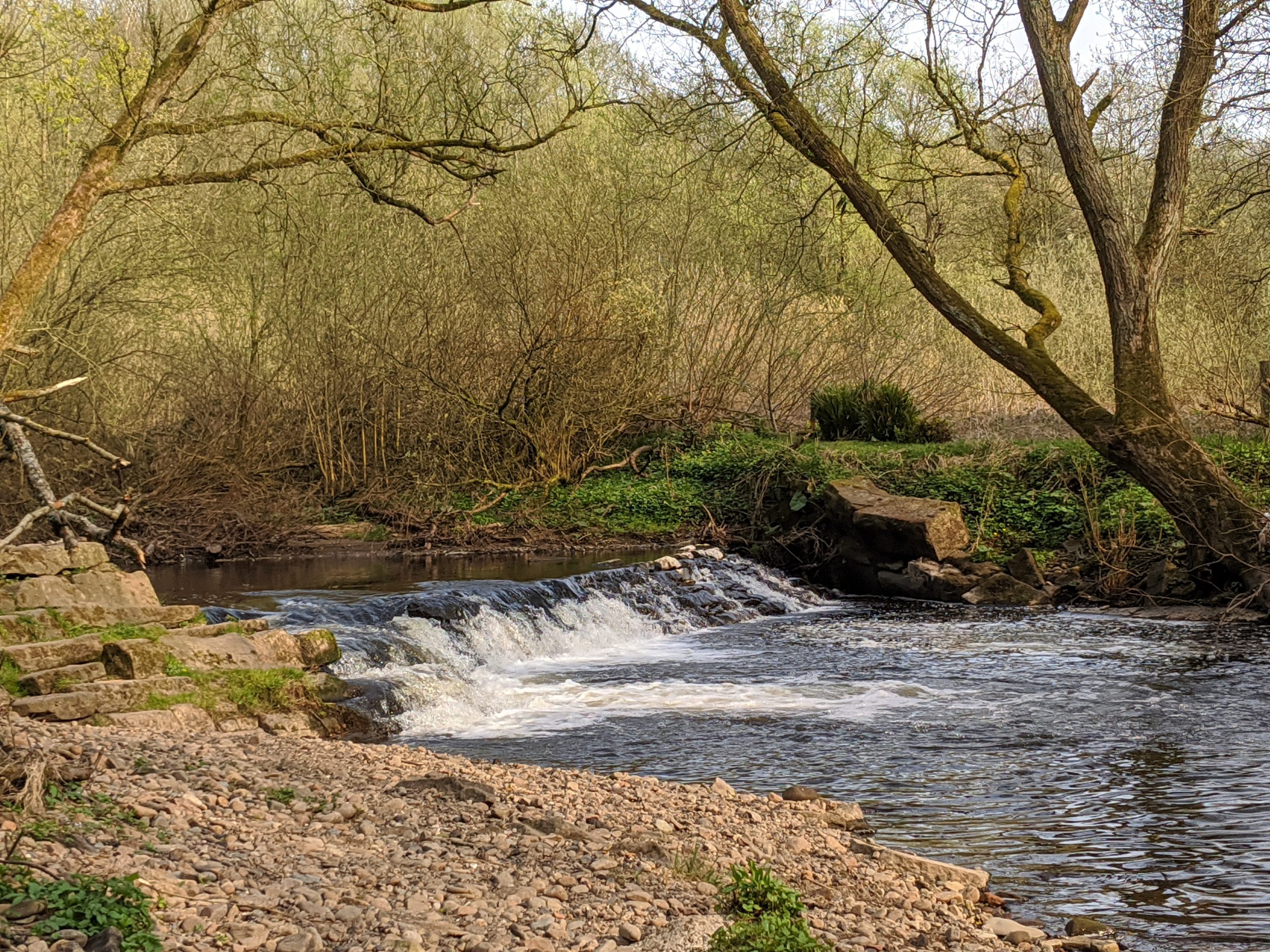
A fantastic read Andrew